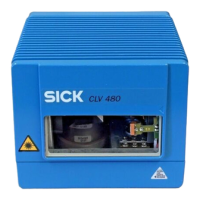Operating Instructions
CLV 480 Bar Code Scanner
8 010 080/O824/10-02-2005 © SICK AG · Division Auto Ident · Germany · All rights reserved I-15
Fig. 10-19: CLV 480-1010/-1011 (line scanner with oscillating mirror):
Min. and Max. radial reading distance as a function of the focus
position at a resolution of 1.00 mm (39.4 mil) and an aperture
angle of 40° ......................................................................................................................10-19
Fig. 10-20: CLV 480-1010/-1011 (line scanner with oscillating mirror):
Min. and Max. radial reading distance as a function of the focus
position at a resolution of 1.00 mm (39.4 mil) and an aperture
angle of 50° ......................................................................................................................10-20
Fig. 10-21: CLV 480-1010/-1011 (line scanner with oscillating mirror): deflection
range as a function of radial reading distance, deflection angle and
resolution............................................................................................................................10-21
Fig. 10-22: External parameter memory, installed on the CLV ............................................10-22
Fig. 10-23: CLV-Setup: "Device configuration" tab with the CLV start options..............10-23
Fig. 10-24: CLV-Setup: dialog box for adjusting the external parameter memory ....... 10-24
Fig. 10-25: CLV with heater: temperature curve inside the housing.................................. 10-26
Fig. 10-26: CLV-Setup: Result display of the AutoBaud Detect function..........................10-33
Fig. 10-27: User interface of the "CLV-Setup" software......................................................... 10-34
Fig. 10-28: CLV-Setup: entering commands in the Terminal Emulator.............................10-39
Fig. 10-29: Line scanner: calculating the number of scans for ladder-type
bar code arrangements................................................................................................ 10-41
Fig. 10-30: Line scanner: calculating the number of scans for fence-type
bar code arrangements................................................................................................ 10-41
Fig. 10-31: Line scanner with oscillating mirror: calculating the number of
scans for fence-type bar code positioning............................................................10-42
Fig. 10-32: One-Shot: Line scanner with oscillating mirror: calculating the
number of scans for fence-type bar code positioning......................................10-43
Fig. 10-33: Required distance between the bar codes on an object................................ 10-44
Fig. 10-34: Auxiliary input via the terminal interface of the CLV...........................................10-46
Fig. 10-35: CLV-Setup: auxiliary input on the Terminal Emulator ........................................10-47
Fig. 10-36: Dimensions of the angle bracket, single No. 2 013 824................................ 10-57
Fig. 10-37: Dimensions of the articulated bracket No. 2 018 435 ................................... 10-57
Fig. 10-38: Front view of quick clamping device No. 2 016 110 with angle
braket No. 2 0130824 ................................................................................................ 10-57
Fig. 10-39: Copy of the Declaration of Conformity (Page 1, scaled down) .....................10-67
Fig. 10-40: Scannable bar codes with various module widths (print ratio 2:1).............10-73

